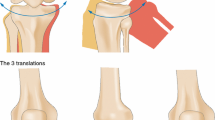Abstract
This study was undertaken to compare the clinical and radiological outcomes achieved using total knee arthroplasty (TKA) with and without a navigation system. This study included 43 TKAs performed with a navigation system and 42 TKAs without a navigation system with a minimum two-year follow-up. We compared clinical outcomes including range of motion, Hospital for Special Surgery (HSS) and Western Ontario and McMaster Universities Osteoarthritis Index (WOMAC) scores at the final follow-up. For radiological comparisons, we evaluated radiological alignment on standing radiographs of knees. HSS and WOMAC scores showed significant improvements at final follow-ups in both groups, but showed no significant inter-group differences (p > 0.05). Similarly, no significant differences were observed in range of motion (p = 0.962). TKAs performed with navigation showed significantly better outcomes in terms of mechanical angle and prosthetic alignment outliers than TKAs performed without navigation. However, we could not find any differences in functional outcomes between TKAs performed with or without a navigation system.
Résumé:
Cette étude a pour but de comparer le devenir clinique et radiologique de prothèses totales du genou avec ou sans utilisation d'un système de navigation. 43 prothèses ont été réalisées avec navigation et 42 sans navigation. Le suivi minimum a été de deux ans. Nous avons comparé les résultats cliniques incluant la mobilité, le score HSS, le score WOMAC. Sur le plan radiologique nous avons évalué les axes en position debout. Les scores HSS et WOMAC montraient une très nette amélioration au suivi final dans les deux groupes mais, sans différence significative entre-eux (p > 0,5). De la même façon nous n'avons pas trouvé de différence significative au niveau de la mobilité (p = 0,962). Par contre, la réalisation d'une prothèse totale du genou avec un système de navigation permet d'améliorer de façon significative l'axe mécanique angulaire de la prothèse en évitant un certain nombre d'anomalies axiales extrêmes que l'on peut rencontrer lorsque l'on réalise ces prothèses sans navigation. Cependant, il n'est pas possible de trouver une différence sur le plan fonctionnel entre les prothèses totales du genou réalisées avec ou sans système de navigation.
Similar content being viewed by others
References
Bathis H, Perlick L, Tingart M, Luring C, Zurakowski D, Grifka J (2004) Alignment in total knee arthroplasty. A comparison of computer-assisted surgery with conventional technique. J Bone Joint Surg Br 86:682–687
Brander VA, Stulberg SD, Adams A, Wood O (2004) CAS-TKA reduces the occurrence of functional outliers. Fourth Annual Meeting of CAOS International, Chicago, 87–88
Bolognesi M, Hofmann A (2005) Computer navigation versus standard instrumentation of TKA: a single-surgeon experience. Clin Orthop Relat Res 440:162–169
Chauhan SK, Scott RG, Breidahl W, Beaver RJ (2004) Computer-assisted knee arthroplasty versus a conventional jig-based technique. A randomised, prospective trial. J Bone Joint Surg Br 86:372–377
Chin PL, Yang KY, Yeo SJ, Lo NN (2005) Randomized control trial comparing radiographic total knee arthroplasty implant placement using computer navigation versus conventional technique. J Arthroplasty 20:618–626
Ensini A, Catani F, Leardini A, Romagnoli M, Giannini S (2007) Alignments and clinical results in conventional and navigated total knee arthroplasty. Clin Orthop Relat Res 457:156–162
Haaker RG, Stockheim M, Kamp M, Proff G, Breitenfelder J, Ottersbach A (2005) Computer-assisted navigation increases precision of component placement in total knee arthroplasty. Clin Orthop Relat Res 433:152–159
Hart R, Janecek M, Chaker A, Bucek P (2003) Total knee arthroplasty implanted with and without kinematic navigation. Int Orthop 27:366–369
Jeffery RS, Morris RW, Denham RA (1991) Coronal alignment after total knee replacement. J Bone Joint Surg Br 73:709–714
Jenny JY, Boeri C (2001) Computer-assisted implantation of total knee prostheses: a case-control comparative study with classical instrumentation. Comput Aided Surg 6:217–720
Kim YH, Kim JS, Yoon SH (2007) Alignment and orientation of the components in total knee replacement with and without navigation support: a prospective, randomised study. J Bone Joint Surg Br 89:471–476
Maculé-Beneyto F, Hernández-Vaquero D, Segur-Vilalta JM, Colomina-Rodríguez R, Hinarejos-Gomez P, García-Forcada I, Seral Garcia B (2006) Navigation in total knee arthroplasty. A multicenter study. Int Orthop 30:536–540
Matsumoto T, Tsumura N, Kurosaka M, Muratsu H, Kuroda R, Ishimoto K, Tsujimoto K, Shiba R, Yoshiya S (2004) Prosthetic alignment and sizing in computer-assisted total knee arthroplasty. Int Orthop 28:282–285
Matziolis G, Krocker D, Weiss U, Tohtz S, Perka C (2007) A prospective, randomized study of computer-assisted and conventional total knee arthroplasty. Three-dimensional evaluation of implant alignment and rotation. J Bone Joint Surg Am 89:236–243
Perlick L, Bathis H, Tingart M, Perlick C, Grifka J (2004) Navigation in total-knee arthroplasty: CT-based implantation compared with the conventional technique. Acta Orthop Scand 75:464–470
Seon JK, Song EK (2004) The accuracy of lower extremity alignment in a total knee arthroplasty using computer-assisted navigation system. J Korean Orthop Assoc 39:566–571
Seon JK, Song EK, Lee JY (2005) Comparison of range of motion of high-flexion prosthesis and mobile-bearing prosthesis in total knee arthroplasty. Orthopedics 28(10 Suppl):S1247–S1250
Sparmann M, Wolke B, Czupalla H, Banzer D, Zink A (2003) Positioning of total knee arthroplasty with and without navigation support. A prospective, randomised study. J Bone Joint Surg Br 85:830–835
Stulberg SD, Laon P, Sarin V (2002) Computer-assisted navigation in total knee replacement: results of an initial experience in thirty-five patients. J Bone Joint Surg Am 84-A(Suppl 2):90–98
Victor J, Hoste D (2005) Image-based computer-assisted total knee arthroplasty leads to lower variability in coronal alignment. Clin Orthop Relat Res 428:131–139
Author information
Authors and Affiliations
Corresponding author
Rights and permissions
About this article
Cite this article
Seon, J.K., Park, S.J., Lee, K.B. et al. Functional comparison of total knee arthroplasty performed with and without a navigation system. International Orthopaedics (SICOT) 33, 987–990 (2009). https://doi.org/10.1007/s00264-008-0594-z
Received:
Revised:
Accepted:
Published:
Issue Date:
DOI: https://doi.org/10.1007/s00264-008-0594-z



